


Deep Vein Thrombosis (DVT) is a serious condition that can affect your health. It involves the formation of blood clots in deep veins, primarily in the legs. If not treated promptly, DVT can lead to life-threatening complications, such as pulmonary embolism. It’s important to recognize the risk factors and symptoms associated with this condition, especially for our elderly population who may feel vulnerable.
Understanding DVT is the first step towards managing it effectively. There are treatment options available, including:
By addressing these concerns early, we can work together to prevent severe outcomes. Remember, you are not alone in this journey; support is available.
If you or a loved one are experiencing symptoms or have questions about DVT, please reach out for help. Your health and well-being are our top priorities, and we are here to guide you through every step of the process. Together, we can ensure that you receive the care you deserve.
Deep Vein Thrombosis (DVT) is a hidden danger that can pose significant health risks, especially for our elderly loved ones. With approximately 1.6 cases occurring per 1,000 individuals each year, understanding DVT is crucial. Timely intervention can save lives and prevent severe complications, such as pulmonary embolism.
Yet, many remain unaware of the symptoms, causes, and effective treatment options available. How can we, as individuals and caregivers, better recognize the signs of DVT? It’s important to navigate the complexities of prevention and management to safeguard our health and the health of those we care for.
Deep Vein Thrombosis (DVT) is a serious condition that can be concerning, especially for our elderly patients, making the use of DVT medicine essential. It is characterized by the formation of a blood mass (thrombus) in a deep vein, most commonly in the legs. This condition presents considerable dangers, as it can lead to severe complications like pulmonary embolism (PE), which may necessitate the use of DVT medicine. In PE, a dislodged blood mass travels to the lungs, which can be fatal. Did you know that the incidence of DVT is approximately 1.6 per 1000 annually, with a prevalence of 1 case per 1000 in the general population? Notably, DVT is the third leading cause of death from cardiovascular disease, following heart attacks and strokes.
For elderly individuals, factors such as reduced mobility and existing health conditions heighten the risk of clot formation, making DVT medicine and early detection crucial. Studies indicate that up to 50,000 cases of DVT are complicated by pulmonary embolism each year in the United States. This underscores the importance of timely diagnosis and intervention. Identifying the signs of DVT—such as swelling, discomfort, and sensitivity—can greatly enhance outcomes for individuals, potentially leading to the need for DVT medicine and improving their quality of life. Prompt treatment with DVT medicine can prevent the progression to more serious complications.
Furthermore, post-thrombotic syndrome, which impacts 43% of individuals two years after a DVT, can lead to long-term health problems. This highlights the necessity for careful monitoring and management in this vulnerable group. At Amavita Heart and Vascular Health, we understand these concerns and offer thorough management of Chronic Venous Insufficiency and Advanced Vascular Disease. We ensure that individuals at high risk receive .
Our advanced imaging capabilities and thorough vascular assessments allow us to address common heart concerns effectively. We want to emphasize the importance of awareness and proactive care. If you or a loved one is experiencing any symptoms or have concerns about DVT, please reach out to us. We are here to provide support and help you navigate your health journey.
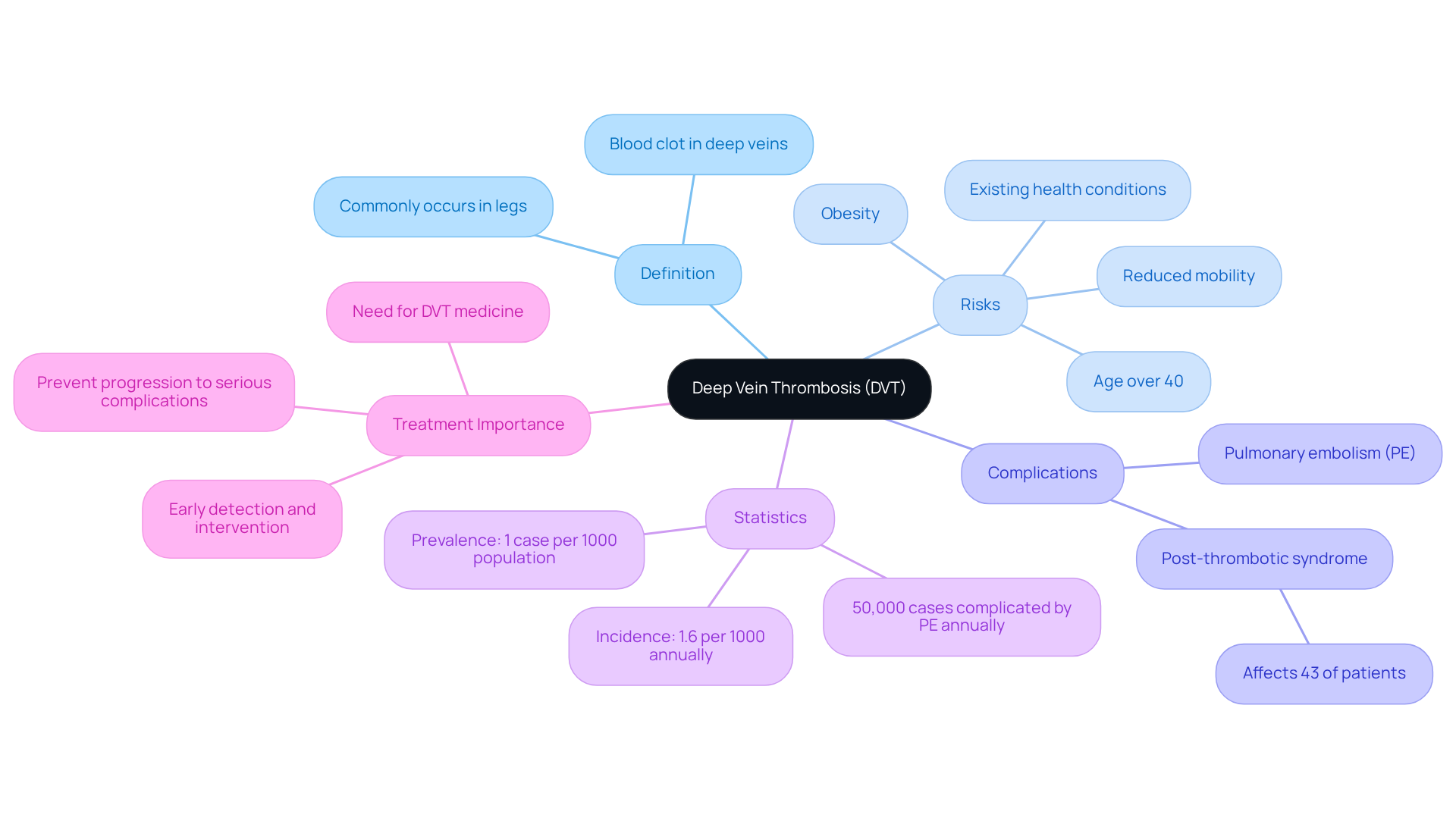
Several factors contribute to the development of deep vein thrombosis (DVT), especially among our elderly loved ones. Prolonged immobility is a significant concern, as sitting or lying down for long periods—such as during lengthy flights or hospital stays—can lead to clot formation. In fact, more than a third of VTE cases diagnosed each year are linked to recent hospitalization, with many incidents occurring after patients return home. This underscores the critical need for preventive measures during and after hospital stays, particularly since as many as 70% of healthcare-associated VTE cases are preventable.
In addition to immobility, there are other risk factors to consider:
Understanding these is crucial for older adults and their caregivers. Proactive actions can significantly reduce the chances of DVT, which may be managed with dvt medicine. For instance, incorporating mobility exercises during extended periods of inactivity can help mitigate issues related to prolonged immobility. It’s also important to recognize that one third to one half of individuals who have experienced a DVT may face long-term complications. This highlights the need for awareness and preventive strategies in dvt medicine. By acknowledging and addressing these factors, individuals can take meaningful steps to protect their vascular health. Remember, you are not alone in this journey; support and resources are available to help you every step of the way.
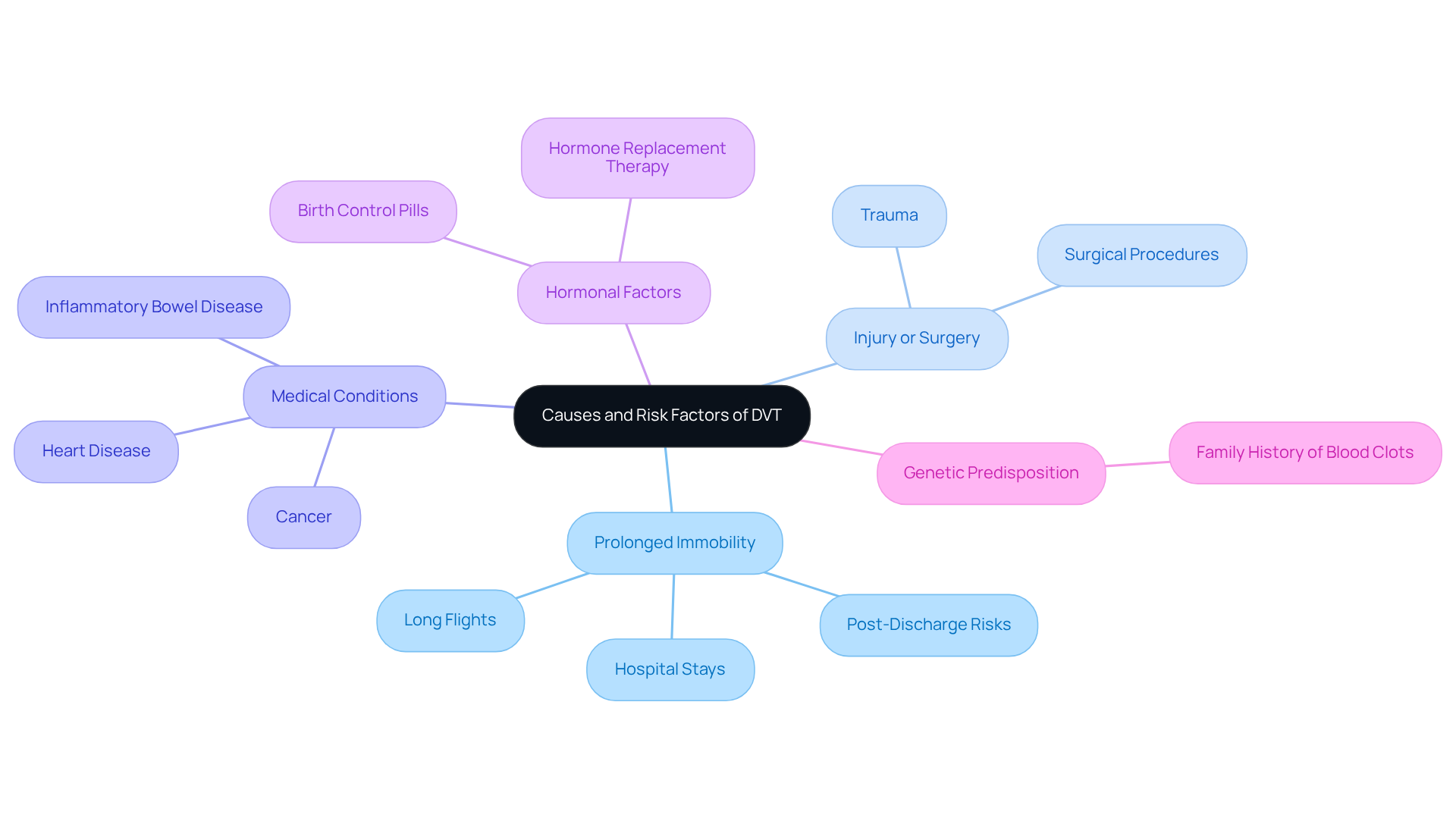
Symptoms of Deep Vein Thrombosis (DVT) can manifest in various ways, and recognizing them early is crucial for effective treatment. Common signs to be aware of include:
Identifying these symptoms early can greatly diminish the likelihood of complications related to DVT. It’s important to know that 30-40% of DVT cases remain undetected due to unusual symptoms. This highlights the necessity of being attentive, especially among older individuals who may be at greater risk. Healthcare professionals emphasize that prompt diagnosis and treatment with DVT medicine are essential to prevent serious complications, such as pulmonary embolism, which can arise if a clot breaks free and travels to the lungs. Dr. Andrei Kindzelski, an NIH blood disease expert, notes that "deep vein thrombosis has classic symptoms—for example swelling, pain, warmth, and redness on the leg."
Case studies have shown that implementing self-care strategies, such as regular movement and leg elevation, can alleviate symptoms and enhance recovery. For instance, a case study on self-care strategies for individuals with DVT emphasizes the effectiveness of these measures in improving outcomes. Furthermore, recognizing risk factors for DVT is crucial, particularly in older individuals. These factors include , recent surgery, and specific medical conditions. Therefore, being aware of these signs and seeking immediate medical attention can lead to better outcomes and an improved quality of life. Remember, you are not alone in this; support is available, and taking action can make a significant difference.

Diagnosing DVT medicine can feel overwhelming, but gaining an understanding of the available methods can help ease your concerns. At Amavita, we prioritize your comfort and well-being through several effective diagnostic approaches.
Prompt and precise diagnosis is essential for effective treatment, especially for those seeking thorough cardiac evaluations and monitoring with dvt medicine. At Amavita, our commitment to advanced imaging and personalized care truly sets us apart, ensuring you receive the highest standard of cardiovascular care. If you have any concerns or questions, please don't hesitate to reach out; we are here to support you every step of the way.
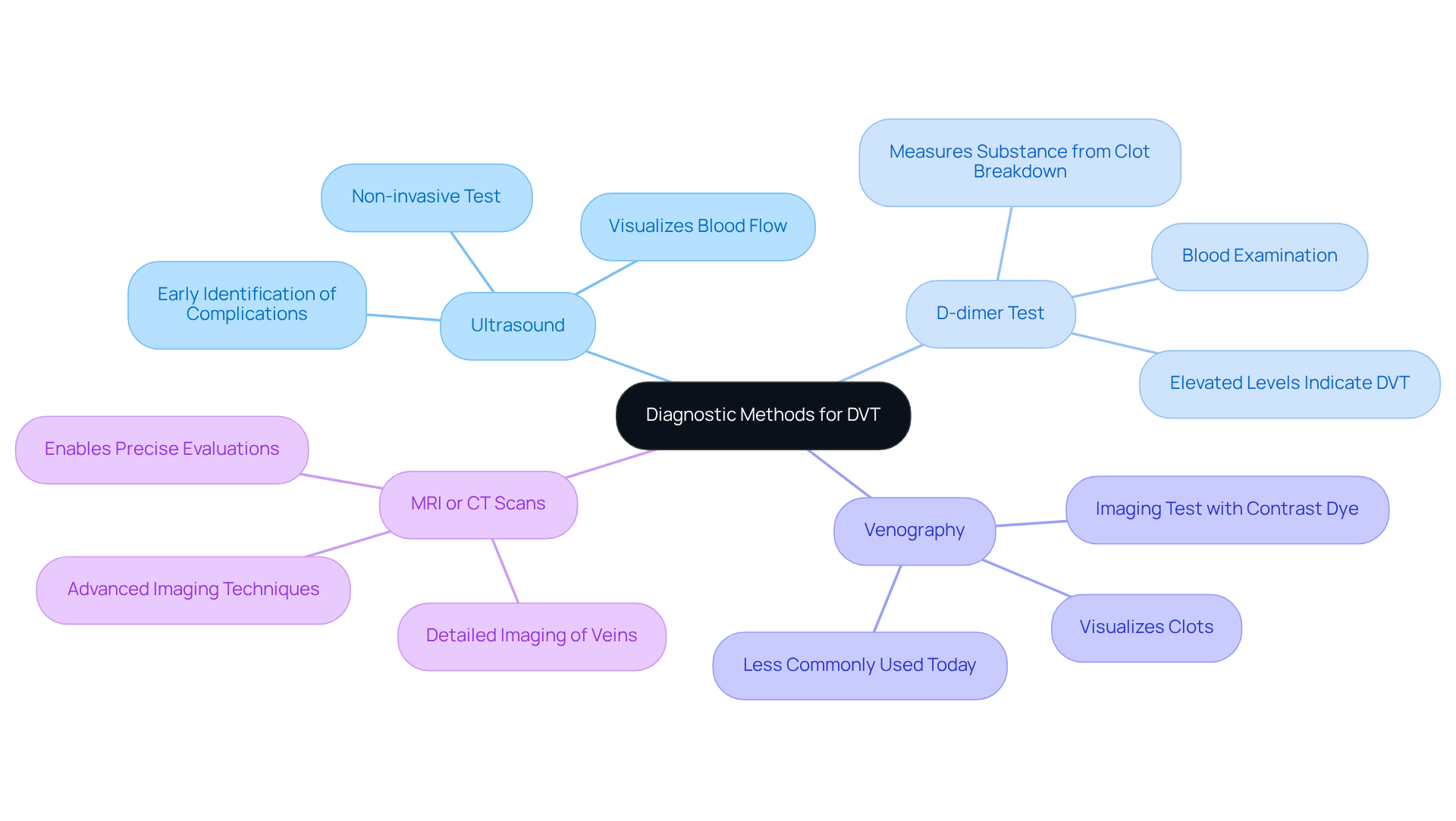
Managing deep vein thrombosis (DVT) is essential for your health, and DVT medicine plays a crucial role in preventing blockages and reducing the risk of pulmonary embolism (PE). Here are some key treatment options that can help you:
Understanding these treatment options, including DVT medicine, can empower you and your family to make informed decisions about managing DVT. Recent studies emphasize the importance of early ambulation and compression, which do not significantly increase the risk of PE and may help alleviate acute symptoms. Researchers strongly recommend combining early ambulation with elastic compression stockings for the best outcomes.
If you have concerns or questions about your treatment options, please don’t hesitate to reach out for support. You are not alone in this journey, and there are ready to help you navigate your health decisions.
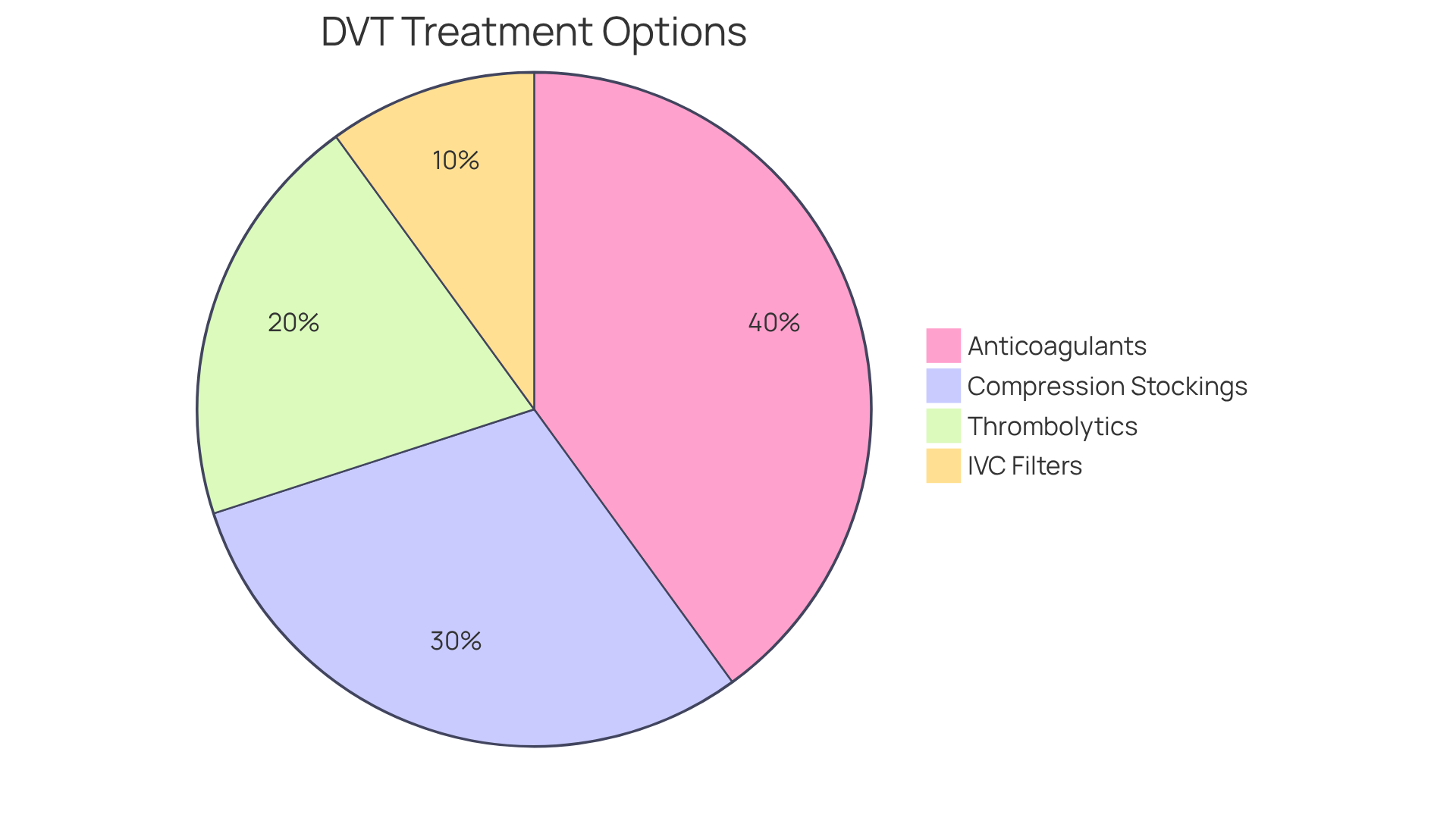
Preventing DVT involves several effective strategies that can significantly lower the risk of developing this serious condition:
By adopting these strategies, you can significantly lower your risk of developing DVT, enhancing your overall cardiovascular health and well-being. Remember, you are not alone in this journey towards better health; support is always available.
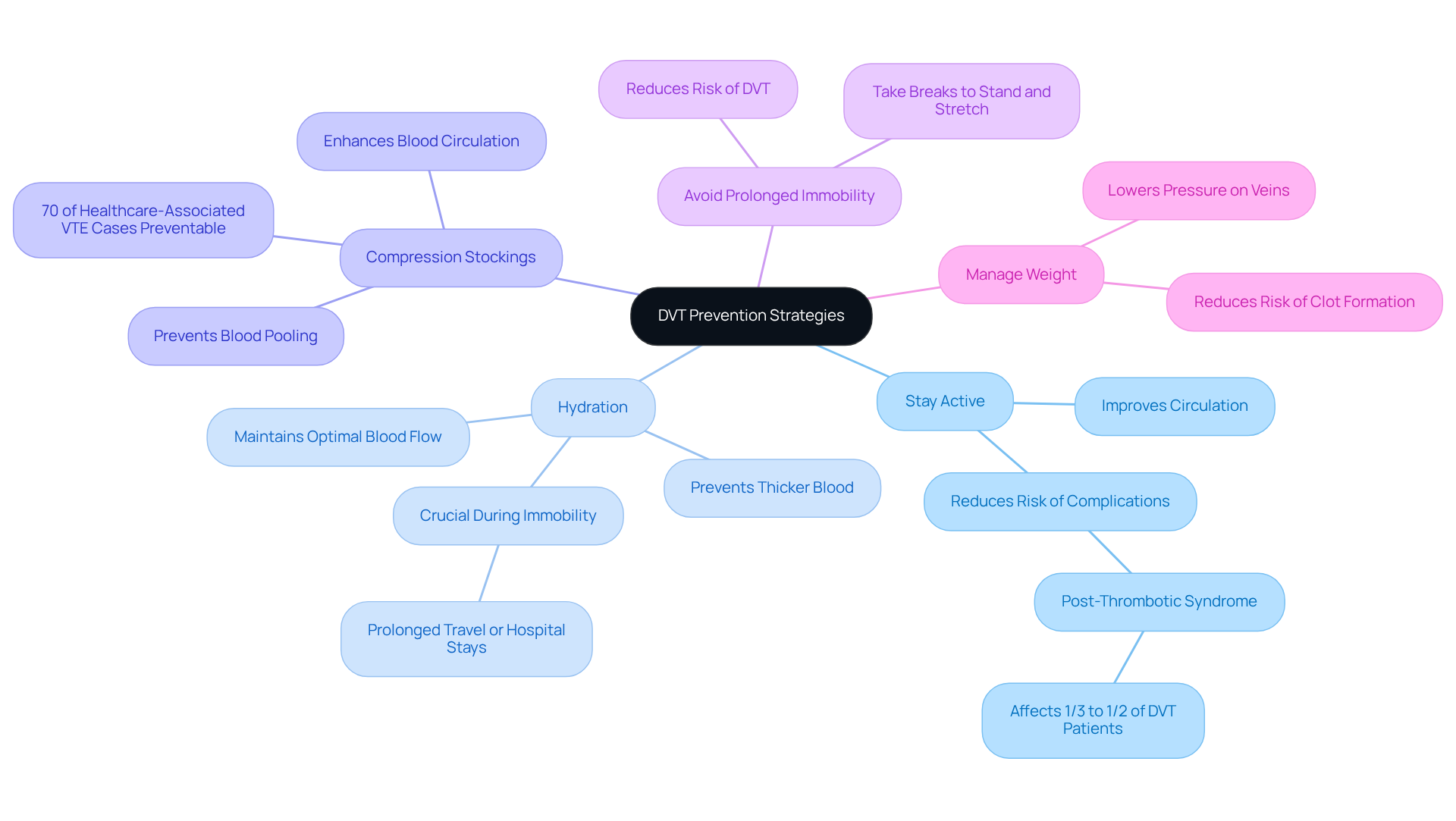
Deep Vein Thrombosis (DVT) is a critical health issue that requires our attention, especially for vulnerable populations such as the elderly. It’s essential to understand the complexities of DVT, including its causes, symptoms, and treatment options, in order to effectively prevent and manage this condition. The importance of timely diagnosis and intervention cannot be overstated; doing so can significantly reduce the risk of severe complications like pulmonary embolism, which poses a serious threat to life.
Key insights highlight various factors contributing to DVT, such as:
Recognizing symptoms like swelling, pain, and warmth is crucial for early detection. Furthermore, diagnostic methods, including ultrasound and blood tests, play a vital role in confirming the presence of DVT, allowing for appropriate treatment strategies to be implemented. Treatment options, ranging from anticoagulants to lifestyle modifications, empower individuals to take control of their vascular health and mitigate long-term risks.
In summary, awareness and proactive measures are pivotal in the fight against DVT. By staying informed about prevention strategies and seeking timely medical advice, individuals can significantly enhance their quality of life and reduce the incidence of this serious condition. Emphasizing the significance of DVT education and management can lead to better health outcomes for many, reinforcing the importance of community support and professional guidance in navigating this health challenge.
What is Deep Vein Thrombosis (DVT)?
Deep Vein Thrombosis (DVT) is a serious condition characterized by the formation of a blood mass (thrombus) in a deep vein, most commonly in the legs. It can lead to severe complications like pulmonary embolism (PE), which can be fatal.
Why is DVT important to recognize and treat?
Recognizing and treating DVT is crucial because it can lead to complications such as pulmonary embolism, which is the third leading cause of death from cardiovascular disease. Timely diagnosis and intervention can prevent serious health issues.
What are the common symptoms of DVT?
Common symptoms of DVT include swelling, discomfort, and sensitivity in the affected area, usually the legs.
What are the risk factors for developing DVT?
Risk factors for developing DVT include prolonged immobility, injury or surgery, chronic medical conditions (such as cancer and heart disease), hormonal factors (like birth control pills), and genetic predisposition to blood clots.
How does prolonged immobility contribute to DVT?
Prolonged immobility, such as sitting or lying down for long periods during flights or hospital stays, can lead to clot formation. More than a third of VTE cases are linked to recent hospitalization.
What percentage of healthcare-associated VTE cases are preventable?
As many as 70% of healthcare-associated VTE cases are preventable, highlighting the need for preventive measures during and after hospital stays.
What is post-thrombotic syndrome and its significance?
Post-thrombotic syndrome affects 43% of individuals two years after a DVT and can lead to long-term health problems, emphasizing the importance of careful monitoring and management.
How can individuals reduce their risk of DVT?
Individuals can reduce their risk of DVT by engaging in mobility exercises during periods of inactivity and being aware of their health conditions and risk factors.
What should someone do if they experience symptoms of DVT?
If someone experiences symptoms of DVT or has concerns about it, they should reach out to healthcare professionals for support and management options.